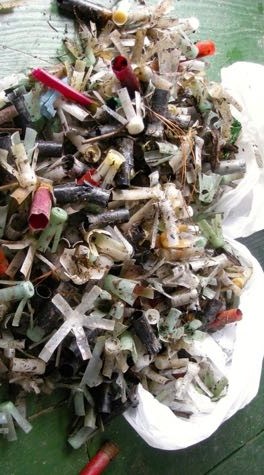Shotgun Wads
 When sportsmen and sportswomen shoot at waterfowl using shotguns, plastic wads that contain the shot are discharged from the shell into the adjoining water. A wad is abandoned with every shot fired, and there is no practical way to recover spent wads which typically travel 30-50 yards. Non-degradable plastic shotgun wads can present safety, nuisance, and environmental impacts in freshwater and estuarine waters. Plastic wads have been reported as a common marine debris item collected during beach cleanups and have been found in the stomachs of foraging birds including albatross.
When sportsmen and sportswomen shoot at waterfowl using shotguns, plastic wads that contain the shot are discharged from the shell into the adjoining water. A wad is abandoned with every shot fired, and there is no practical way to recover spent wads which typically travel 30-50 yards. Non-degradable plastic shotgun wads can present safety, nuisance, and environmental impacts in freshwater and estuarine waters. Plastic wads have been reported as a common marine debris item collected during beach cleanups and have been found in the stomachs of foraging birds including albatross.
The term “wad” refers to a component of a shotgun shell that is used to separate the shot from the powder, contain the shotgun shot, and provide a seal that prevents gas from blowing through the shot rather than propelling the shot out of the shotgun. The shotgun shell has a plastic case and after firing the shotgun, the case remains in the shotgun and is manually discharged by the operator, while the wad leaves the gun along with the shot. State regulations require hunters to retain their spent casings and properly dispose of them, in an effort to prevent littering, but the plastic wads travel significant distances after the gun is fired and cannot easily be recovered.

